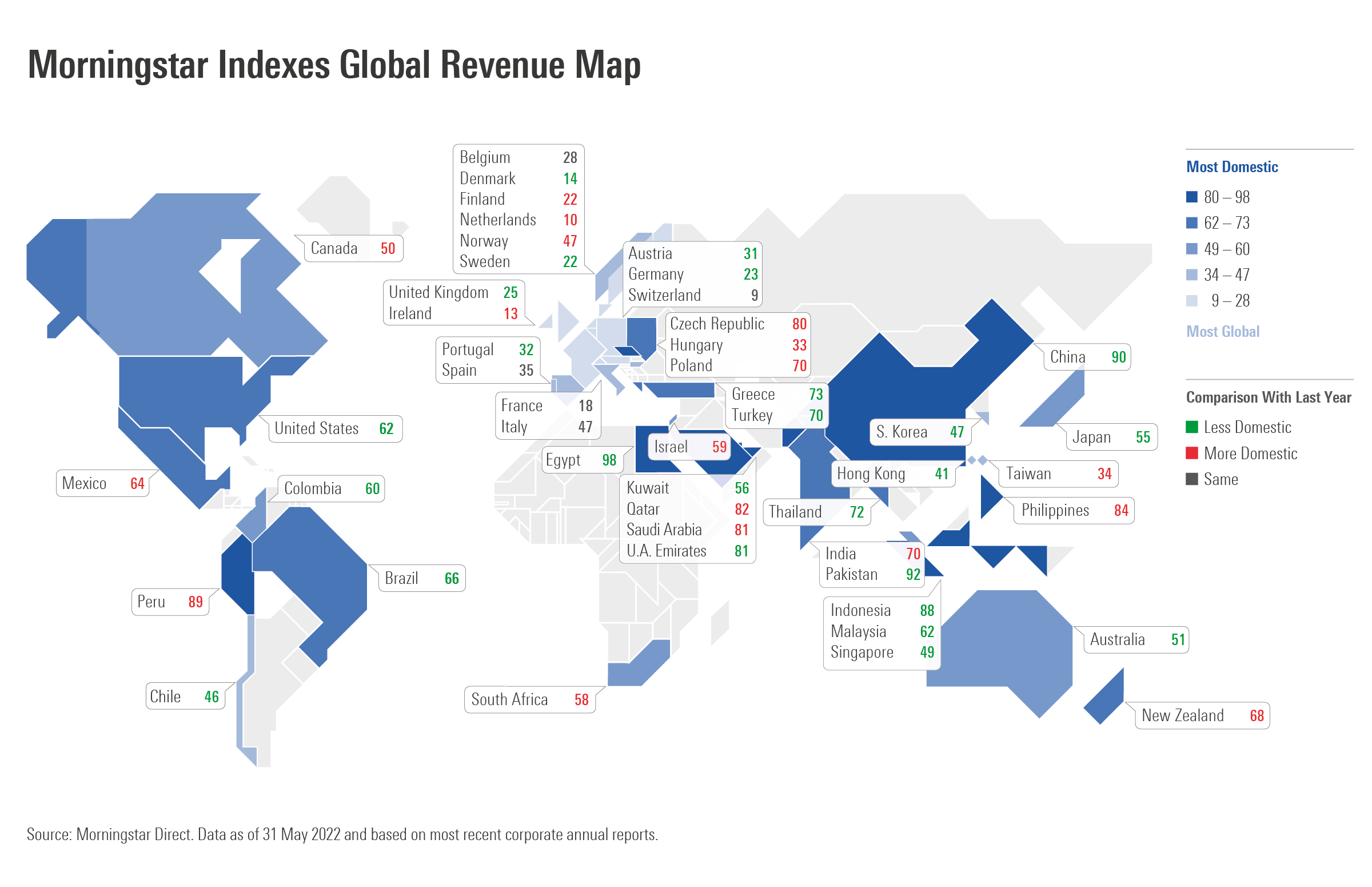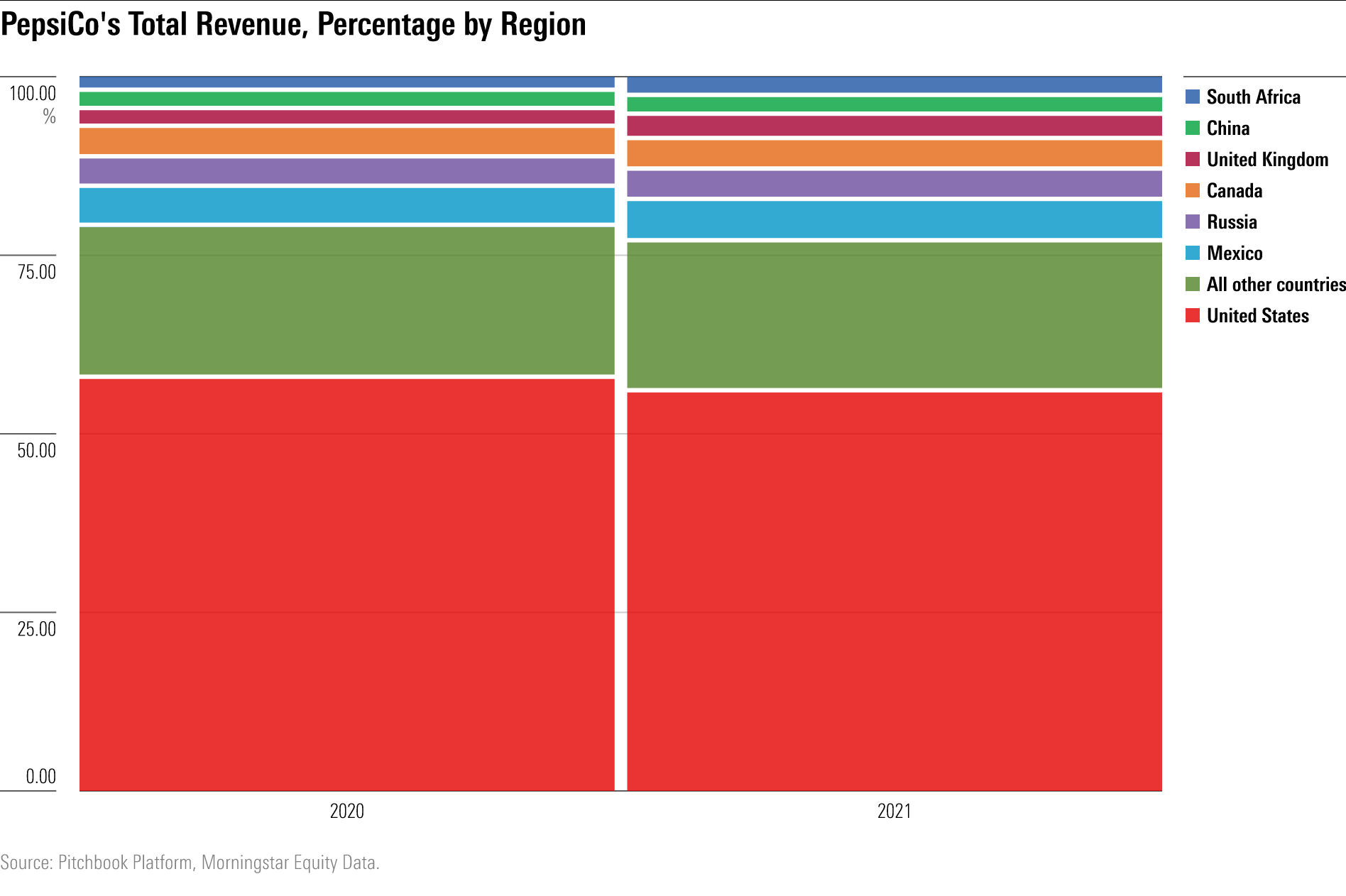This July Fourth, the U.S. Equity Market Looks a Little Less Star-Spangled
In an era of onshoring and localization, revenue sources are still globalizing.

In aggregate, the U.S. equity market sources 62% of its revenue domestically. That figure fell from 63% when we examined the data in June 2021. Companies are increasingly looking abroad, according to geographic revenue segment data for the 1,638 constituents of the Morningstar US Market Index, a broad gauge of large-, mid-, and small-cap stocks.
The United States is part of a global trend. When geographic revenue sources were examined for Morningstar’s 48 national equity market indexes, we found that most became less domestic over the past year. Countries across region, size, and development status increased their global connections compared with this time last year.

Deepening globalization runs contrary to the dominant current narrative. We live in a “postglobal world,” according to the title of a new book describing a trend toward “localization.” A recent issue of The Economist focuses on “Reinventing Globalisation.” “Offshoring,” popular in the 1990s and 2000s, has become a dirty word, while “onshoring,” “reshoring,” and “slowablization” are trending. Even before the pandemic, inflation, and war in Europe exposed the weaknesses in global supply chains, political currents had turned against globalization. Independence and self-sufficiency are ascendant.
Pursuing Revenue Streams Across Borders
To understand what’s going on, remember the truism that stock markets are markets of stocks. Market-level trends are driven by the behavior of their underlying businesses. Consider PepsiCo PEP, the U.S.-based food and beverage giant classified in the consumer defensive sector. In 2021, Pepsi’s revenue from carbonated drinks and salty snack sales outside the U.S. grew by a faster rate than its domestic business. Like many companies, Pepsi doesn’t specify all sources of global revenue. What’s sure is that Russia won’t be one of Pepsi’s top markets when it reports for 2022. The company exited the country after the Ukraine invasion.

Pepsi is among many global giants operating from the U.S., the world’s largest equity market. Many of the largest public companies, including Microsoft MSFT, Alphabet GOOGL, Meta Platforms META, and Nvidia NVDA earn the majority of revenues from outside the U.S.
But other big constituents of the Morningstar US Market Index, like Berkshire Hathaway BRK.A, UnitedHealth UNH, Amazon.com AMZN, and JPMorgan Chase JPM, are largely domestically focused. The technology sector is the most global, while utilities, real estate, and financials are the most domestic. And smaller companies tend to be more domestic than larger ones. After the U.S., China and the eurozone are the two biggest sources of revenue for the Morningstar US Market Index (both roughly 9%), according to Morningstar estimates.
Emerging Markets Remain the Most Domestic, Europe the Most Outward-Looking
The world’s four largest equity markets—the U.S., Japan, the United Kingdom, and China—all source a larger share of revenue internationally than they did last year. None of the moves were dramatic. Japan went from 57% domestic a year ago to 55% this year. The U.K. went from 27% to 25%, and China from 91% to 90%.
Emerging markets, such as Egypt, Pakistan, China, Peru, Indonesia, the Philippines, and Persian Gulf states, remain the most domestically oriented. The fact that the Morningstar China Index sources an estimated 90% of revenue from China, despite the Chinese economy’s export orientation, can be explained by the domestic focus of its top constituents Tencent TCEHY, Alibaba BABA, Meituan MPNGY, China Construction Bank CICHY, and JD.com JD.
European markets remain the world’s most outward-looking. With the exception of Greece, which is largely domestic, European markets are dominated by global companies. The Morningstar Switzerland Index, which includes Nestle NSRGF, Roche RHHBY, and Novartis NVS, is the most global, with the U.S. representing an estimated 30% of its revenues. Amazingly, the Morningstar Netherlands Index sources more revenue from Taiwan (an estimated 13%) than from the Netherlands (10%). It’s less surprising to see countries with small populations like Ireland and Denmark among the world’s outward-oriented, than it is for larger economies like France, Germany, and the U.K. Other European countries are the largest sources of revenue for the Morningstar Europe Index, followed by the U.S. (an estimated 22%) and China (9%).
Economic sectors do not seem to be strong drivers of change from last year. For example, some resources-heavy markets became more global, including Australia, Brazil, Chile, and the United Arab Emirates; but others, like Canada, Peru, Saudi Arabia, Norway, South Africa, and Qatar did not. The market for resources is obviously global, so producers might be expected to increase international revenues in an era of high prices and soaring demand.
Similarly, no clear trend was discernible within technology-heavy markets. The U.S., Korea, and Germany—all of which have significant tech representation—globalized. Taiwan, the Netherlands, Israel, and India did not.
Canada and Australia both source roughly half of revenues from outside their markets. They are also both resources-heavy markets dominated by a few large banks, and their economies and populations are comparable in size. But whereas Canada sources an estimated 30% of revenue from the U.S., China is the biggest external market for Australia at 13%. Only Taiwan (18%) and Hong Kong (17%) depend more on Chinese revenues.
The U.S. represents more than 20% of revenue for Ireland, Canada, Switzerland, Denmark, Taiwan, the U.K., Germany, France, and Belgium. The old adage about when the U.S. sneezes, others catch the flu comes to mind.
Revenue Sources Blur the Lines Between Domestic and Foreign
The fact that equity markets are globalizing certainly runs counter to the narrative that supply chains are onshoring and countries are pursuing self-sufficiency. But the stock market is not the economy. Revenue sources for public companies represent just a piece of the mosaic. There are many other ways to measure economic globalization—the most common being trade as a percentage of gross domestic product.
For investors, globalized revenue sources blur the lines between the domestic and international portions of a portfolio. While it’s true that global exposure can often come through domestic companies, it’s also true that leading players in an investor’s home market may be based offshore. As ever, a global portfolio offers the broadest opportunity set.
Morningstar, Inc. licenses indexes to financial institutions as the tracking indexes for investable products, such as exchange-traded funds, sponsored by the financial institution. The license fee for such use is paid by the sponsoring financial institution based mainly on the total assets of the investable product. A list of investable products that track or have tracked a Morningstar index is available on the resources tab at indexes.morningstar.com. Morningstar, Inc. does not market, sell, or make any representations regarding the advisability of investing in any investable product that tracks a Morningstar index.
The author or authors do not own shares in any securities mentioned in this article. Find out about Morningstar’s editorial policies.

/s3.amazonaws.com/arc-authors/morningstar/033528a9-55cc-40aa-90a9-8d2d98697cf5.jpg)
/cloudfront-us-east-1.images.arcpublishing.com/morningstar/GJMQNPFPOFHUHHT3UABTAMBTZM.png)
/cloudfront-us-east-1.images.arcpublishing.com/morningstar/ZYJVMA34ANHZZDT5KOPPUVFLPE.png)
/cloudfront-us-east-1.images.arcpublishing.com/morningstar/LDGHWJAL2NFZJBVDHSFFNEULHE.jpg)
:quality(80)/s3.amazonaws.com/arc-authors/morningstar/033528a9-55cc-40aa-90a9-8d2d98697cf5.jpg)